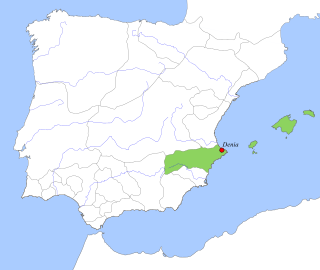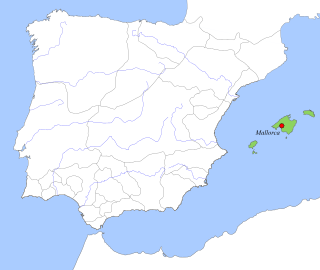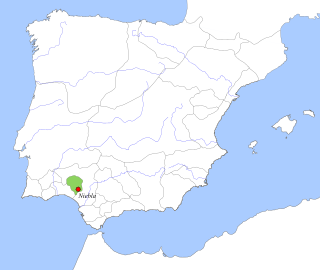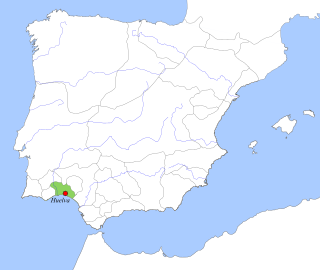 W
WThe taifas were the independent Muslim principalities of the Iberian Peninsula, referred to by Muslims as al-Andalus, that emerged from the decline and fall of the Umayyad Caliphate of Córdoba between 1009 and 1031. They were a recurring feature of Andalusian history. Conquered by the Almoravids in the late 11th century, on its collapse many taifas re-appeared only to be subsumed by the Almohads. The fall of the latter resulted in a final flourishing of the taifas, but by the end of the 13th century only one remained, Granada, the rest being incorporated into the Christian states of the north.
 W
WThe Taifa of Albarracín was a medieval Berber taifa kingdom. The polity existed from 1012 to 1104, and was centered at the city of Albarracín. It was led by the Berber dynasty of the Banu Razin of Houara tribe, which arrived in the peninsula after the conquest of Spain by Tariq ibn Ziyad.
 W
WThe Taifa of Algeciras was a medieval Muslim taifa kingdom in what is now southern Spain and Gibraltar, that existed from 1035 to 1058.
 W
WThe Taifa of Almería was a Muslim medieval Arab kingdom located in what is now the province of Almería in Spain. The taifa originated in 1012 and lasted until 1091.
 W
WThe Taifa of Alpuente was a medieval Berber taifa kingdom that existed from around 1009 to 1106 created following the end of the Caliphate of Córdoba in the Iberian Peninsula in 1010. It was ruled by the Kutama Berber family of the Banū Qāsim.
 W
WThe Taifa of Arcos was a Berber medieval taifa kingdom that existed in two periods; first from 1011 to 1068. Ruled by the Zanata Berber family of the Banū Jizrūn. From 1068 until 1091 it was under the forcible control of Seville, by Abbad II al-Mu'tadid. It regained its independence from 1143 to 1145 when it was finally conquered by the Almohad Caliphate.
 W
WThe Taifa of Carmona was a medieval Berber taifa kingdom. It existed for two distinct periods: first from 1013 to 1066 when it was conquered by the Taifa of Seville, and secondly from around 1143 to 1150 when it was finally conquered by the Almohad Caliphate. The taifa was established and ruled by the Zenata Berber Birzalid dynasty.
 W
WThe Taifa of Córdoba was an Arab taifa which was ruled by the Banu Jawhar that replaced the Umayyad Caliph as the government of Córdoba and its vicinity in 1031.
 W
WThe taifa of Dénia was an Islamic Moorish kingdom in medieval Spain, ruling over part of the Valencian coast and Ibiza. With Dénia as its capital, the taifa included the Balearic Islands and parts of the Spanish mainland.
 W
WThe Taifa of Majorca was a medieval Moorish taifa kingdom which existed from 1018 to 1203 in Majorca.
 W
WThe Taifa of Mértola was a medieval Moorish taifa that existed in what is now southeastern Portugal. It existed during three distinct periods: from 1033 to 1044, from 1144 to 1145, and from 1146 to 1151. From 1044 until 1091 it was under the forcible control of the Taifa of Seville, by Abbad II al-Mu'tadid. Its short-lived history ended in 1151, when it was finally conquered by the Almohad Caliphate.
 W
WThe Taifa of Morón was a medieval Berber taifa kingdom that existed from around 1010 to 1066. From 1066 until 1091 it was under the forcible control of Seville, by Abbad II al-Mu'tadid.
 W
WThe Taifa of Murcia was an Arab taifa of medieval Al-Andalus, in what is now southern Spain. It became independent as a taifa centered on the Moorish city of Murcia after the fall of the Umayyad Caliphate of Córdoba. Moorish Taifa of Murcia included Albacete and part of Almería as well.
 W
WThe Taifa of Niebla was an Arab taifa kingdom that existed during three distinct time periods: from 1023 to 1053, from 1145 to 1150 and from 1234 to 1262.
 W
WThe Taifa of Ronda was a medieval Berber taifa kingdom centered in Moorish al-Andalus in what is now southern Spain. It existed from 1039 to 1065. The taifa was ruled by a family from the Berber Banu Ifran tribe of North Africa. Its capital was the city of Ronda. From 1065 until 1091, the taifa was under the control of the Taifa of Seville, led by Abbad II al-Mu'tadid.
 W
WThe Taifa of Saltés and Huelva was a medieval Arab taifa kingdom that existed in southern Iberia from around 1012 to 1051. From 1051 until 1091 it was under the forcible control of Seville, by Abbad II al-Mu'tadid.
 W
WThe Taifa of Santa Maria do Algarve was a medieval taifa Moorish kingdom or emirate located in what is now southern Portugal, that existed from 1018 to 1051. From 1051 until 1091, it was under the forcible control of Seville via Abbad II al-Mu'tadid. Known as the Banu Harun, their descendants remained as Qadis of the city until its reconquest by Portugal in 1249, the last of whom being Aloandro Ben Bekar.
 W
WThe Taifa of Silves was an Arab taifa kingdom that existed in what is now southern Portugal for two distinct periods: from 1027 to 1063, and again from 1145 to 1150, when it was finally conquered by the Almohad Caliphate.
 W
WThe taifa of Toledo was a Berber Muslim taifa located in what is now central Spain. It existed from the fracturing of the long-eminent Muslim Caliphate of Córdoba in 1035 until the Christian conquest in 1085.